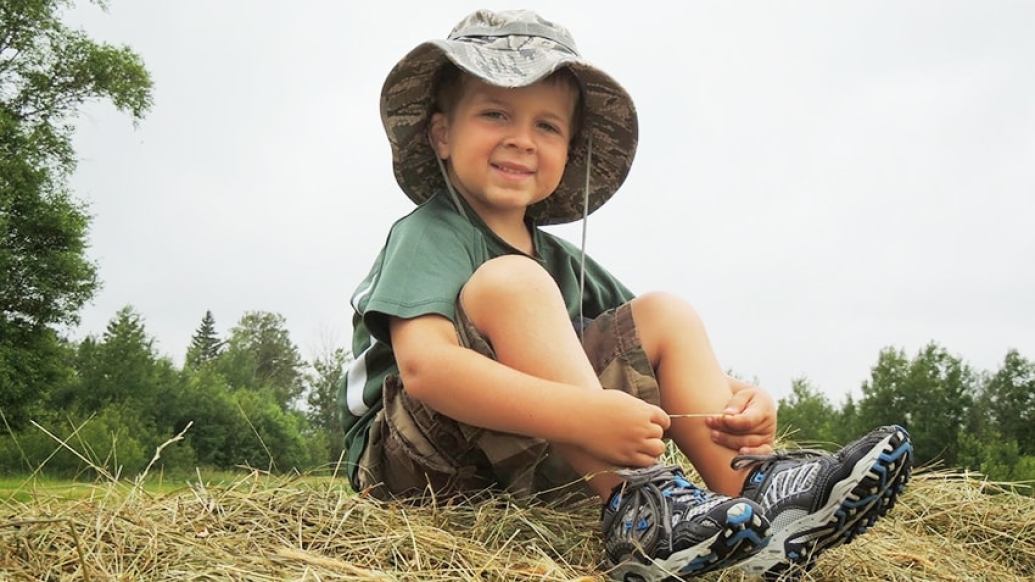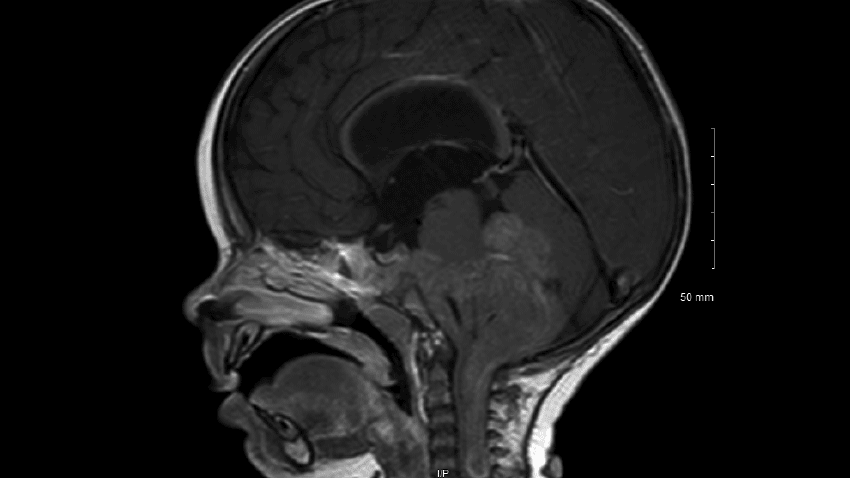Loyal to a U-M athletic rival, a young boy beats his cancer with the help of Wolverine doctors.
7:00 AM
Author |

Ian Anderson always had the same greeting as he was wheeled out of radiation therapy appointments at University of Michigan C.S. Mott Children's Hospital.
SEE ALSO: 'Mr. 1 Percent' Celebrates His 5th Birthday
After fist-bumping the doctors, nurses and staff, the 2-year-old would smile and say, "Go State."
"When he was born, 'Spartan will' came through his blood," says his mother, Gina, referring to the recent school slogan adopted by athletic rival Michigan State University.
A lifelong Spartan fan, Ian, now 8, is known for proudly sporting green and white apparel to his hospital visits, reminding U-M doctors which team he roots for on the football field.
But at Mott, where he fought against a deadly brain tumor as a toddler, Ian is still seen as a mighty "Little Victor."
"He just has such great enthusiasm for life and, of course, for Michigan State," says Karin Muraszko, M.D., chair of the U-M Medical School's Department of Neurosurgery.
"He was always very honest with us about how much he loves the Spartans. But we are all on one team, and that team is taking care of Ian."
The third-grader, naturally, will be cheering on his beloved Spartans as they take on the Wolverines in East Lansing this weekend.
Meanwhile, he is celebrating victory in a much bigger battle. Next month marks his six-year anniversary of being cancer-free.
Trouble and teamwork
It was Mother's Day in 2009 when Gina noticed strange symptoms in Ian, who, at 15 months old, was suddenly not walking or responding as usual.
SEE ALSO: Identical 5-Year-Old Twins with Identical Cancers
A series of tests at a hospital near the Andersons' home in Bay City, Michigan, prompted Ian's quick transfer to Mott the same night.
Doctors there told Gina and husband Dan that Ian had a cancerous tumor in the back of his brain that extended through his spinal cord and had blocked the flow of spinal fluids.
The size of a grapefruit, the tumor needed to be removed as soon as possible.
"He was basically moments away from death," Gina says.
Ian's high-risk surgery required intense teamwork by three pediatric neurosurgeons, including Muraszko and Mott surgeons Hugh Garton, M.D., and Cormac Maher, M.D. Each took turns throughout the procedure that began at 7:30 a.m. on a Tuesday and ended at 5:30 a.m. the next day.
Over 22 hours, doctors carefully took apart the toddler's skull and spinal cord to remove tumor tissue in his brain and that had wrapped around his cervical nerves, brain stem and blood vessels.
They removed one small piece at a time, diligently working around nearby structures, including nerves that control the vocal chords and the tongue and key functions such as swallowing, breathing and upper neck and arm movement.
The surgeons then put the bones of Ian's skull and his spinal cord back into place.
Ian woke up with a head bandage next to his Sparty pillow — and, to everyone's amazement, no traces of ever having a tumor.
Muraszko told the family it was a "home run."
"We were just happy to see him breathing, eating and swallowing after surgery," Garton says. "This was as good an outcome as we could have hoped for — a combination of choosing the right things to do, cooperation and being very fortunate that the tumor tissue wasn't so firmly attached to Ian's critical structures that removing it would cause damage."
As for the patient's athletic loyalties, there are no hard feelings.
"Nothing gives me greater pleasure than to see him here today with that big smile and giant Spartan jersey," Garton says.

Back in the game
Despite a successful operation, the fight wasn't over.
For the next 17 months, little Ian underwent several rounds of chemotherapy and radiation to ensure all of the cancer cells were gone and to reduce chances of a reoccurrence.
He completed his last official treatment on Nov. 8, 2010.
"He knows he's a miracle," Gina says. "We are lucky that our life has moved so far from cancer that we are living life beyond it now. He barely even remembers going through it."
Today, Ian, known for his gray-green eyes and charming smile, has a long bucket list that includes swimming with sharks, skydiving, bungee jumping, reading every book and swimming in every ocean.
Such daredevil goals should come as no surprise. Gina says Mott pediatric oncologist Patricia Robertson, M.D., has remarked that Ian is known for "having no fear."
And he proved that recently after riding the 310-foot-tall, 93 mph Millennium Force roller coaster at the Cedar Point amusement park in Sandusky, Ohio.
That was a big deal, Gina says, because a major concern of undergoing chemo at such a young age was how the treatments might affect his growth.
Since that ride, many more celebrated milestones have occurred.
"We always say he lives one giggle at a time. He's so full of joy and adventure. He just lights up the room," Gina says. "We see him as a true messenger of hope. He just inspires us, and we soak up every little moment that we might otherwise have taken for granted."
Beyond reading, ice skating and playing with siblings Greer, 10, and Easton, 13, Ian loves watching the Spartans.
He has even officially become part of the Spartan family as an honorary member of the MSU hockey team thanks to a connection through the Friends of Jaclyn Foundation, a charitable group. Ian accompanies the players to practices and games and has formed close friendships with them, the coaches and the team's head trainer.
U-M care teams, meanwhile, have jokingly (and unsuccessfully) tried to persuade their young Spartan to switch alliances.
But Ian's parents, who had their first date at the Spartan Stadium in 1998, know their child isn't likely to budge.
Gina, who with Dan will attend the football game this weekend, says the whole family plans to cheer for green and white until the very end — even though they now have a soft spot for the Wolverines.
"As much as we are die-hard Spartans, we are so grateful for the Michigan teams who saved Ian's life," Gina says. "There's no better place than Mott."

Explore a variety of health care news & stories by visiting the Health Lab home page for more articles.

Department of Communication at Michigan Medicine
Want top health & research news weekly? Sign up for Health Lab’s newsletters today!





